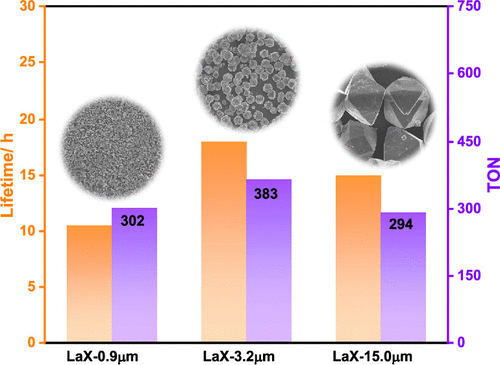当前位置:
X-MOL 学术
›
Ind. Eng. Chem. Res.
›
论文详情
Our official English website, www.x-mol.net, welcomes your feedback! (Note: you will need to create a separate account there.)
Elucidating the Zeolite Particle Size Effect on Butene/Isobutane Alkylation
Industrial & Engineering Chemistry Research ( IF 4.2 ) Pub Date : 2022-01-05 , DOI: 10.1021/acs.iecr.1c02038 Zhiqiang Yang 1, 2 , Ruirui Zhang 2 , Ruixia Liu 2, 3 , Suojiang Zhang 1, 2, 3
Industrial & Engineering Chemistry Research ( IF 4.2 ) Pub Date : 2022-01-05 , DOI: 10.1021/acs.iecr.1c02038 Zhiqiang Yang 1, 2 , Ruirui Zhang 2 , Ruixia Liu 2, 3 , Suojiang Zhang 1, 2, 3
Affiliation

|
In this study, X zeolites with average particle sizes of 0.9, 3.2, and 15.0 μm (labeled as NaX-0.9 μm, NaX-3.2 μm, and NaX-15.0 μm) were prepared. The latter two samples were single crystals, while NaX-0.9 μm was an aggregate composed of nanosized crystals. After being transferred to their La forms, the alkylation performances of the zeolites were examined in a continuous-flow slurry reactor. Contrary to the general belief that reducing the particle size can effectively enhance catalyst stability, the results showed that LaX-3.2 μm exhibited better stability than the other two samples. This phenomenon was explained by the balance between acidity and diffusion resistance. Although LaX-15.0 μm possessed very similar acidities to LaX-3.2 μm, its active sites cannot be fully utilized due to the diffusion limitations associated with the larger particle size. As for LaX-0.9 μm, although it was theoretically favorable for product diffusion, it also suffered from more significant dealumination because of the high structural defect concentrations. As a result, LaX-0.9 μm yielded lower Brønsted acidity, higher Lewis acidity, and weaker acid strength, all of which were disadvantageous for alkylation. Given the tradeoff effect between diffusion resistance and acidity, there is speculated to be an optimal particle size for LaX zeolites when used in a slurry reactor for alkylation. Furthermore, suggestions on catalyst design for isobutane alkylation were provided based on our results.
中文翻译:

阐明沸石粒度对丁烯/异丁烷烷基化的影响
在本研究中,制备了平均粒径为 0.9、3.2 和 15.0 μm(标记为 NaX-0.9 μm、NaX-3.2 μm 和 NaX-15.0 μm)的 X 沸石。后两个样品是单晶,而NaX-0.9 μm是由纳米级晶体组成的聚集体。在转移到它们的 La 形式后,沸石的烷基化性能在连续流动的淤浆反应器中进行了检查。与降低粒径可以有效提高催化剂稳定性的普遍看法相反,结果表明 LaX-3.2 μm 比其他两个样品表现出更好的稳定性。这种现象可以通过酸度和扩散阻力之间的平衡来解释。尽管 LaX-15.0 μm 具有与 LaX-3.2 μm 非常相似的酸度,由于与较大粒径相关的扩散限制,其活性位点无法充分利用。至于 LaX-0.9 μm,虽然理论上有利于产品扩散,但由于结构缺陷浓度高,它也遭受了更严重的脱铝。结果,LaX-0.9 μm 产生较低的布朗斯台德酸度、较高的路易斯酸度和较弱的酸强度,所有这些都不利于烷基化。考虑到扩散阻力和酸度之间的折衷效应,推测当在淤浆反应器中用于烷基化时,LaX 沸石的最佳粒度。此外,基于我们的结果,提供了异丁烷烷基化催化剂设计的建议。由于结构缺陷浓度高,它还遭受了更严重的脱铝。结果,LaX-0.9 μm 产生较低的布朗斯台德酸度、较高的路易斯酸度和较弱的酸强度,所有这些都不利于烷基化。考虑到扩散阻力和酸度之间的折衷效应,推测当在淤浆反应器中用于烷基化时,LaX 沸石的最佳粒度。此外,基于我们的结果,提供了异丁烷烷基化催化剂设计的建议。由于结构缺陷浓度高,它还遭受了更严重的脱铝。结果,LaX-0.9 μm 产生较低的布朗斯台德酸度、较高的路易斯酸度和较弱的酸强度,所有这些都不利于烷基化。考虑到扩散阻力和酸度之间的折衷效应,推测当在淤浆反应器中用于烷基化时,LaX 沸石的最佳粒度。此外,基于我们的结果,提供了异丁烷烷基化催化剂设计的建议。据推测,当在淤浆反应器中用于烷基化时,LaX 沸石具有最佳粒径。此外,基于我们的结果,提供了异丁烷烷基化催化剂设计的建议。据推测,当在淤浆反应器中用于烷基化时,LaX 沸石具有最佳粒径。此外,基于我们的结果,提供了异丁烷烷基化催化剂设计的建议。
更新日期:2022-01-19
中文翻译:

阐明沸石粒度对丁烯/异丁烷烷基化的影响
在本研究中,制备了平均粒径为 0.9、3.2 和 15.0 μm(标记为 NaX-0.9 μm、NaX-3.2 μm 和 NaX-15.0 μm)的 X 沸石。后两个样品是单晶,而NaX-0.9 μm是由纳米级晶体组成的聚集体。在转移到它们的 La 形式后,沸石的烷基化性能在连续流动的淤浆反应器中进行了检查。与降低粒径可以有效提高催化剂稳定性的普遍看法相反,结果表明 LaX-3.2 μm 比其他两个样品表现出更好的稳定性。这种现象可以通过酸度和扩散阻力之间的平衡来解释。尽管 LaX-15.0 μm 具有与 LaX-3.2 μm 非常相似的酸度,由于与较大粒径相关的扩散限制,其活性位点无法充分利用。至于 LaX-0.9 μm,虽然理论上有利于产品扩散,但由于结构缺陷浓度高,它也遭受了更严重的脱铝。结果,LaX-0.9 μm 产生较低的布朗斯台德酸度、较高的路易斯酸度和较弱的酸强度,所有这些都不利于烷基化。考虑到扩散阻力和酸度之间的折衷效应,推测当在淤浆反应器中用于烷基化时,LaX 沸石的最佳粒度。此外,基于我们的结果,提供了异丁烷烷基化催化剂设计的建议。由于结构缺陷浓度高,它还遭受了更严重的脱铝。结果,LaX-0.9 μm 产生较低的布朗斯台德酸度、较高的路易斯酸度和较弱的酸强度,所有这些都不利于烷基化。考虑到扩散阻力和酸度之间的折衷效应,推测当在淤浆反应器中用于烷基化时,LaX 沸石的最佳粒度。此外,基于我们的结果,提供了异丁烷烷基化催化剂设计的建议。由于结构缺陷浓度高,它还遭受了更严重的脱铝。结果,LaX-0.9 μm 产生较低的布朗斯台德酸度、较高的路易斯酸度和较弱的酸强度,所有这些都不利于烷基化。考虑到扩散阻力和酸度之间的折衷效应,推测当在淤浆反应器中用于烷基化时,LaX 沸石的最佳粒度。此外,基于我们的结果,提供了异丁烷烷基化催化剂设计的建议。据推测,当在淤浆反应器中用于烷基化时,LaX 沸石具有最佳粒径。此外,基于我们的结果,提供了异丁烷烷基化催化剂设计的建议。据推测,当在淤浆反应器中用于烷基化时,LaX 沸石具有最佳粒径。此外,基于我们的结果,提供了异丁烷烷基化催化剂设计的建议。



























 京公网安备 11010802027423号
京公网安备 11010802027423号